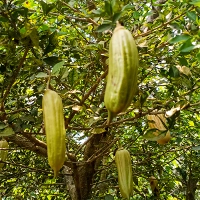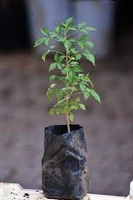Candle Fruit Live Plants (Parmentiera Cereifera)
Product description
Candle fruit, scientifically known as Parmentiera cereifera, is a tropical tree that produces distinctive and unusual fruits. Here's a description of candle fruit live plants:
-
Tree Appearance: Candle fruit trees are medium-sized to large evergreen trees that can reach heights of up to 15 meters (49 feet). They have a straight trunk and a relatively symmetrical crown of foliage.
-
Leaves: The leaves of candle fruit trees are simple, alternate, and dark green in color. They are typically elliptical or ovate in shape and have a smooth texture.
-
Fruit: The most notable feature of the candle fruit tree is its fruit, which resembles a candle or a cylindrical, elongated shape. The fruit can grow to be quite large, often around 20 to 30 centimeters (8 to 12 inches) in length and 4 to 6 centimeters (1.5 to 2.4 inches) in diameter. When ripe, the fruit turns yellow or orange and has a waxy, smooth skin. Inside, it contains a whitish to yellowish flesh that is edible. The taste is mild, often described as somewhat bland or similar to a cross between a cucumber and a melon.
-
Seeds: Candle fruit typically contains numerous small, flat, and round seeds embedded in the flesh. These seeds are not typically consumed.
-
Flowers: The tree produces small, inconspicuous flowers that are often greenish-white or yellowish. The flowers are usually borne in clusters.
-
Habitat: Candle fruit trees are native to tropical regions of Central and South America, particularly in countries like Mexico, Belize, and Guatemala. They thrive in warm, humid climates and are often found in rainforests or tropical woodlands.
-
Cultivation: Candle fruit trees can be grown from seeds and require a tropical climate to thrive. They prefer well-drained soils and regular watering. These trees are grown primarily for their unique fruit.
-
Uses: The primary use of candle fruit is for its unusual fruit, which can be eaten fresh or used in various culinary applications. In some regions, the fruit is used to make drinks and desserts. The wax-like texture of the fruit's skin has led to its common name, "candle fruit."
-
Conservation Status: While not widely cultivated, candle fruit trees are not considered endangered. However, like many tropical tree species, they may face habitat destruction and deforestation threats in their native range.
-
Other Names: Candle fruit is also known by other names in different regions, including "cuachilote" in Mexico and "vela" in Guatemala.
In summary, the candle fruit live plant is valued for its unique, candle-shaped fruit. While the fruit itself may not have an exceptionally strong flavor, it is appreciated for its novelty and is sometimes used in culinary preparations in its native regions.
✦
You might like these
✦










